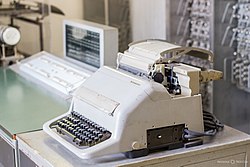Teletypewriter
A teletypewriter (TTY; also called a teletype or teleprinter) is a device that sends a typed message to another place. A teletypewriter has a typewriter keyboard, a local printer (so the user can see what has been typed) and a transmitter. Messages can be sent over wires or radio waves. Teletypes were used mostly in the early to mid-20th century. They were developed to improve telegraphs, some of which also used keyboards, though not typewriter keyboards.
Though teleprinters have been replaced by other technologies, TDDs (Telecommunications Devices for the Deaf), which are based on the idea and design of teletypes, are still used these days. Not all people who are deaf, hard of hearing, or speech-impaired have switched to using instant messaging or texting or other modern services. Many still type messages back and forth to one another by TDD.
Teletypewriter Media
Example of teleprinter art: a portrait of Dag Hammarskjöld, 1962
Hughes telegraph, an early (1855) teleprinter built by Siemens and Halske. The centrifugal governor to achieve synchronicity with the other end can be seen.
Keyboard of a Baudot teleprinter, with 32 keys, counting the space bar (only partially visible in this picture; the key left blank in this layout is not the space bar)
International Telegraph Alphabet No. 2 development of the Baudot–Murray code
A Creed & Company Teleprinter No. 7 in 1930
Siemens Fernschreiber 100 teleprinter
A Teletype Model 33 ASR teleprinter, with punched tape reader and punch, usable as a computer terminal







